On Dec. 18, 1953, what was then the largest and most powerful helicopter in the Western world first took to the air at the Sikorsky Plant in Stratford, Connecticut. That aircraft — the Sikorsky S-56 — was enormous in pretty much every aspect: 88 feet (27 meters) long, with five 72-foot (22-meter) all-metal main rotor blades, and a tail rotor with four 15-foot (4.5-meter) blades. Inside, the massive 1,250-cubic-foot (35-cubic-meter) cabin provided enough space for 26 fully-equipped troops. It was also the first twin-engine helicopter from Sikorsky to serve in the United States military, was notable for having retractable landing gear and an early automatic stabilization system, and was the first helicopter to have main rotor and tail rotor de-icing.
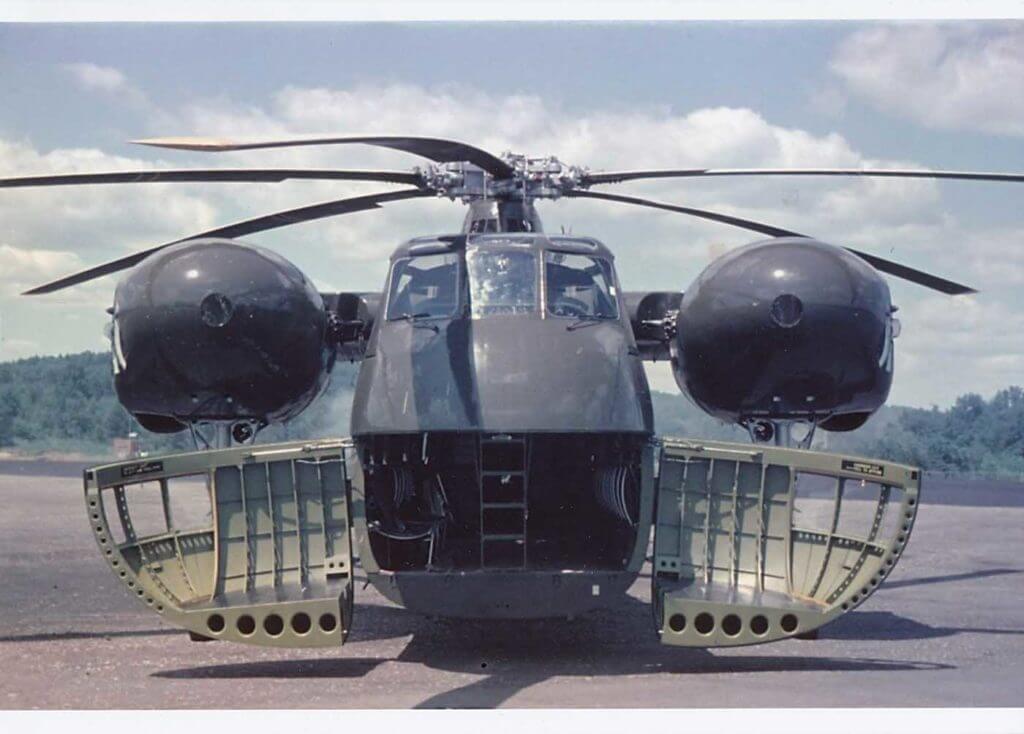
The S-56 was designed in 1950 in response to the U.S. Navy’s request for an assault helicopter. Sikorsky submitted a proposal called the XHRS-A (later given the military designation XHR2S-1). The “X” indicated the helicopter was an experimental prototype; “H” stood for helicopter; “R” for transport; the “2” was for it being the second transport helicopter (the S-55 was the first); and “S” was for Sikorsky.
The aircraft was powered by two 2,100-shaft-horsepower Pratt and Whitney R-2800 Double Wasp radial piston engines, which were mounted on nacelles at the tip of a short high wing. The wings were to help provide lift in forward flight.
The all-metal helicopter had large clamshell doors in the nose to allow jeeps and trucks to be driven straight into the cavernous cabin, which measured seven feet, eight inches (two meters) wide; six feet, eight inches (two meters) high; and 30 foot, 4 inches (9.2 meters) long.
The cockpit for the two pilots was located in the nose of the helicopter above the cargo compartment. There were two sets of throttles for the pilots — one overhead and the other a twist grip that allowed the pilots to make power adjustments.
A cargo hatch in the center of the cabin floor had a sling capable of lifting 10,000 pounds (4,535 kilograms). It had an additional electric cargo hoist mounted on the ceiling along a monorail that could lift 2,000 lb. (905 kg). The helicopter was thirsty, and had two 400-US gallon (1,515 liter) fuel tanks.

Sikorsky had considered a proposal for a compound variant of the type that had stub wings and pusher propellers, and even offered the Navy a turbine-powered version. However, the Navy chose the basic S-56 model, as it had the least technical risk. On May 9, 1951, it gave Sikorsky an order for four experimental XHR2S-1s. These aircraft were extensively evaluated by the U.S. Marine Corps.
An advanced design
The S-56 experimental program represented a major advancement in helicopter design for Igor Sikorsky. The aircraft was four times larger than the S-55/H-19 — the company’s first transport helicopter. When introduced, the S-56 was not only the largest piston helicopter ever constructed in North America, but also the biggest and fastest rotary-wing aircraft.
It was the first Sikorsky helicopter with automatic main rotor blade folding and a folding pylon, enabling the helicopter to fit on aircraft carrier elevators. Additionally, it had an auxiliary power unit that enabled electricity to power the cargo winch, but development of these systems ended up taking Sikorsky additional time to perfect.
The U.S. Marine Corps was the initial customer for the HR2S-1/S-56 utility helicopter, which was nicknamed “The Deuce.”
Operated by a crew of three, the S-56 had an empty weight of 20,831 lb. (9,470 kg) and a maximum takeoff weight of 31,000 lb. (14,090 kg). In terms of its performance, it had a maximum speed of 130 mph (209 km/h) with a cruise speed of 115 mph (185 km/h). It had a range of 145 miles (233 kilometers), a service ceiling of 8,700 feet (2,650 meters), with a rate of climb of 1,732 feet a minute (8.66 meters a second).
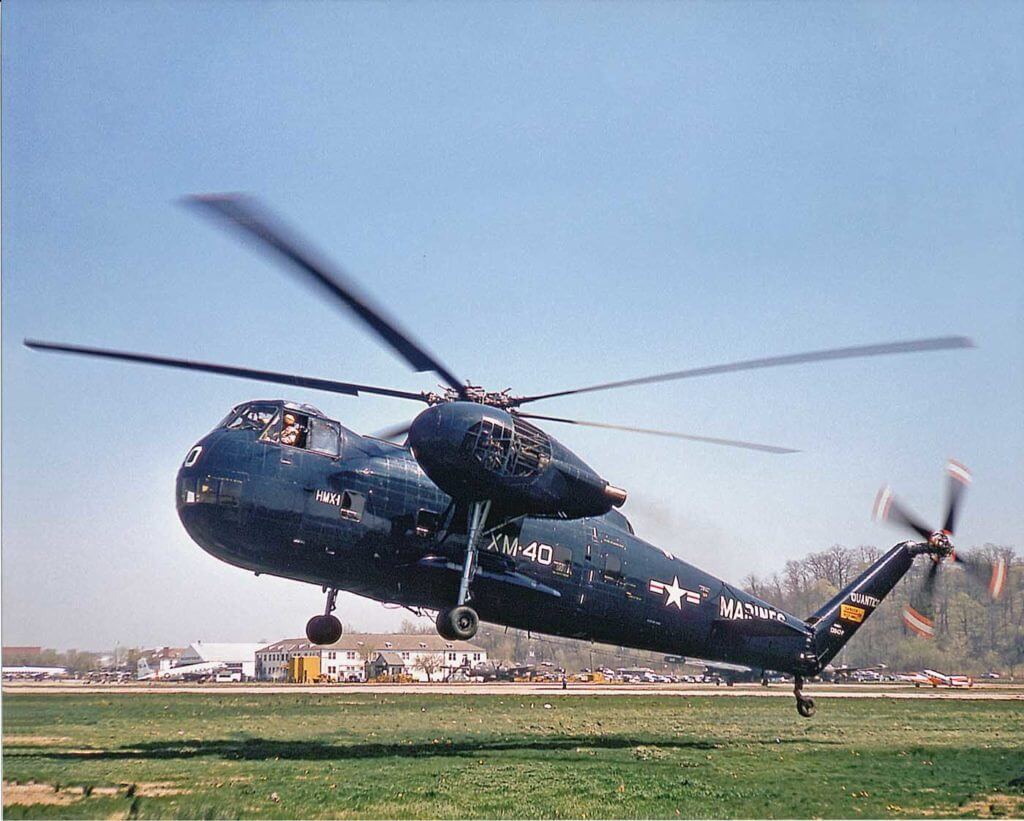
The aircraft would also set three world records: a speed record without payload (162.7 miles per hour/261.8 kilometers per hour); a record altitude (12,100 feet/3,688 meters); and a load carrying record of 13,227 lb. (6,000 kg) to 6,561 feet (2,000 meters).
But while 180 HR2S-1 helicopters were ordered for the Marines, only 60 were finally delivered. The first arrived for evaluation at Marine Helicopter Squadron One (HMX-1) in Quantico, Virginia, in July 1956. The first operational S-56 Marine Corps squadron was formed at New River, North Carolina, in January 1957. A second was set up at the Marine Corps Air Station in Santa Ana, California. All S-56s ordered by the Marines were delivered by the early 1960s, but the Marine Deuce would only deploy on ships in squadron strength on one occasion.
Unique to the Marine version of the HR2S-1 Marine helicopter production version was a dorsal fin on the back of the helicopter. A few of the Marines’ helicopters were modified with a large search radome under the nose. These were designated as the HR2S-1W as a patrol aircraft. This aircraft required additional crewmembers for radar duties, helping to spot-low flying enemy aircraft. However, this program wasn’t deemed a great success.
Sikorsky tested a Marine XHRS2-1 with a V-shaped twin tail rotor system, designed to improve the center of gravity range and increase the forward speed of the helicopter. Both four blade and five blade tail rotors were used in the evaluation, but the results indicated little improvement to the helicopter, and the program was dropped.
A further design trial took place in 1959, when Sikorsky experimented with a six-bladed main rotor, wanting to understand the impact of the extra blade on the aircraft’s flight characteristics. That was as far as the development went, though, and the six-bladed rotor was never used operationally on the S-56.
Joining the Army
In 1954, the U.S. Army tested a Sikorsky S-56/Navy XHR2S-1 helicopter, designated the YH-37, as a potential troop and cargo carrier. The test program resulted in an immediate order for nine of the type, but this eventually grew to 94 H-37As, which the Army called the “Mojave.”
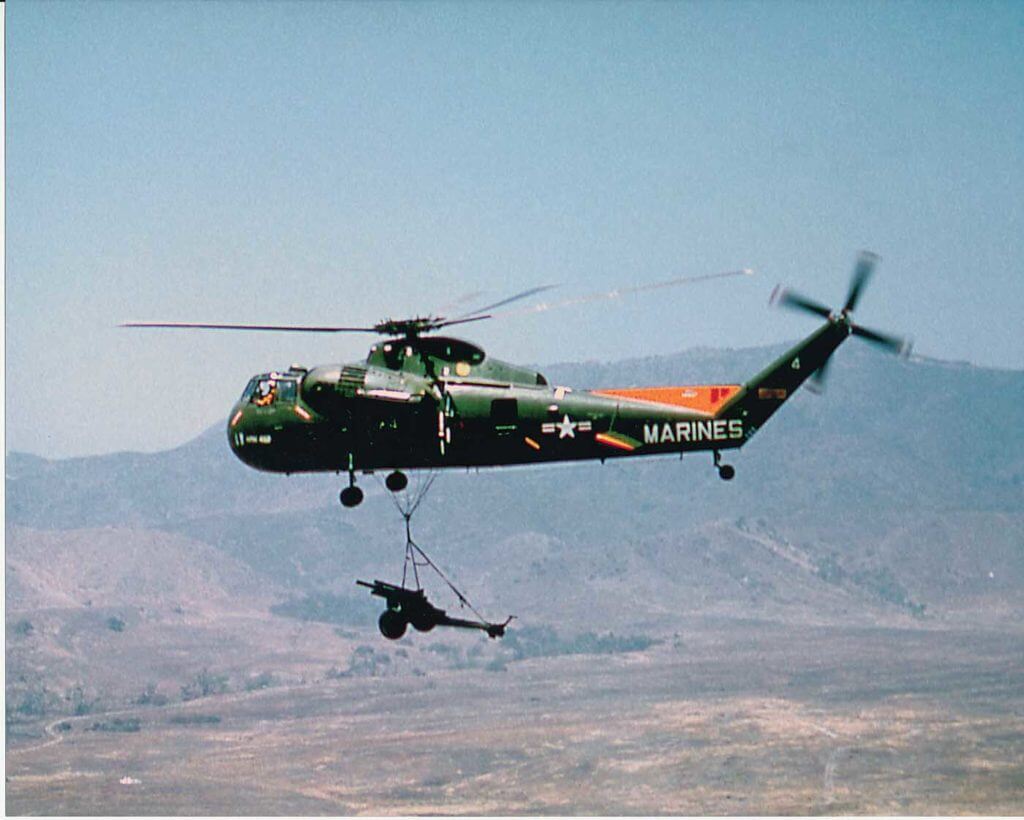
The Army version featured a manually folding main rotor, and hydraulically folding tail rotor pylon. The first Mojaves went to Fort Rucker in Alabama in the summer of 1956, and the last was delivered in June 1960.
The first operational Mojave unit in the Army was established at Fort Benning, Georgia, in February 1958. The following year, Army Mojaves were shipped to West Germany to support the U.S. forces in Europe. The Army reportedly found the Mojave very reliable and quite easy to maintain.
Ninety of the helicopters were returned to Sikorsky for upgrading to the H-37B configuration, completed in 1961. This moved the stabilizer to the top of the tail rotor pylon, added larger 30-US gallon (115-liter) oil tanks, and automatic stabilization equipment — thus allowing an instrument flight system for the aircraft, and hands off flying capabilities. The rear split cargo door was also replaced with a sliding cargo door.
The Army also evaluated the Navy HR2S-1W radar patrol helicopter with the chin radome, operating it in an Army Arctic two-tone paint scheme. However, no sales materialized for this version.
During 1962, an Army Mojave helicopter was fitted with special recovery gear that was used to catch parachutes carrying missile cones and data capsules during space experiments. It was known as MARS (Mid-Air Recovery System). The Mojave flew in above the parachutes and snagged them with a recovery hook. This became a routine successful operation.
Four CH-37Bs were shipped to Vietnam in 1963 to help in the recovery of downed U.S. aircraft. By December that year, the CH-37Bs had recovered $7.5 million of equipment, sling-loading the damaged aircraft from inaccessible terrain. It appears at least one CH-37B was lost to enemy fire. Despite the success of the operation, the Mojaves returned to the U.S. shortly afterwards.
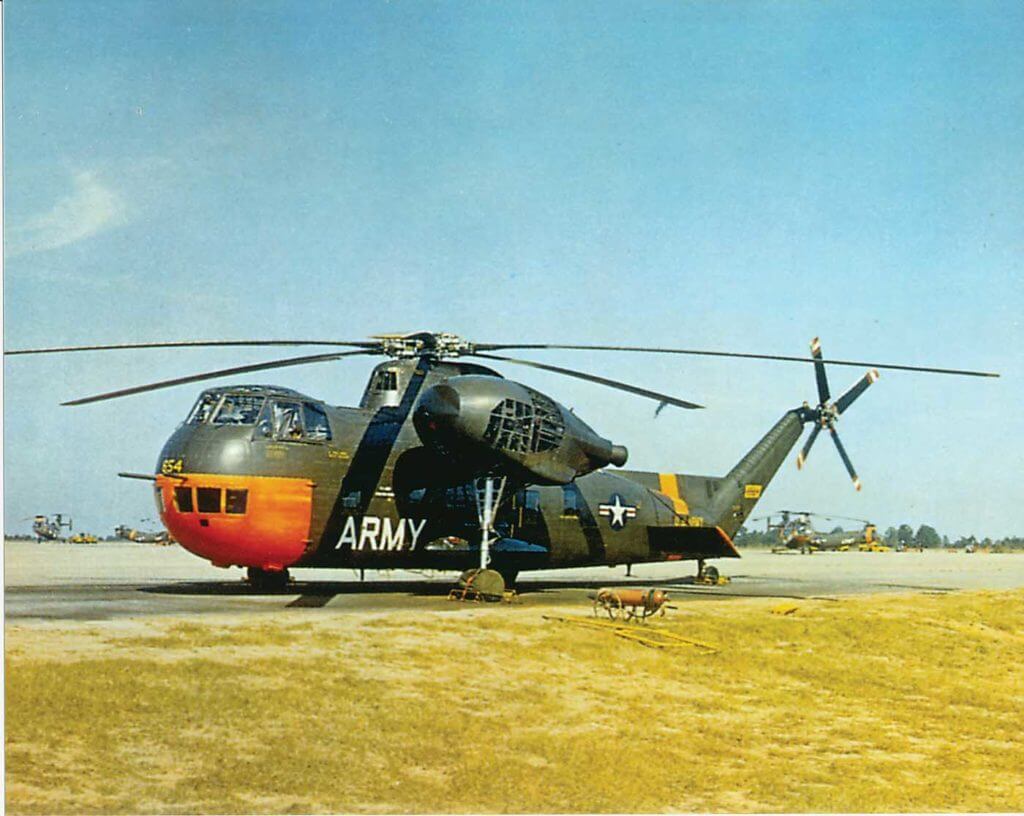
During the mid-1960s, Army CH-37s were deployed to Korea, where they were used for evacuation duties during major floods, for logistical support in the mountainous areas, and in support of the president when he visited in 1966.
By the late 1960s, the Mojaves were withdrawn from the Army and transferred to Army National Guard units throughout the U.S. They were used by the National Guard until 1974, before going into storage.
Eight Marine Deuce HR2S-1 helicopters were sent to Vietnam in September 1965 to support the Marine Air Group. They carried out over 1,500 missions, moving equipment and 31,000 personnel without one air accident. This was a real testament of faith for the type, which had pioneered heavy-lift operations in Vietnam.
But, with the arrival of the turbine CH-53 helicopter in 1967, the Marine Corp HR2S-1’s days were also numbered. After a successful 10 years in service and 5,300 hours of flight in Vietnam, the Deuce helicopters were all shipped back to the U.S. for storage at the Davis-Monthan Air Force Base in Arizona. Some S-56 helicopters were believed to have been abandoned overseas.
Sikorsky manufactured a total of 154 S-56s. Vibrations in the cockpit caused some issues for the aircraft in service, but, overall, it turned out to be a great performer for the military.
The S-56 in retirement
Sikorsky briefly considered selling the S-56 for use in commercial operations in 1958, but the market never materialized, largely due to the aircraft’s exorbitant fuel consumption and very high operating costs. And with half an eye on new advanced turbine helicopter designs, Sikorsky also dropped plans to modify the S-56 to turbine engines.
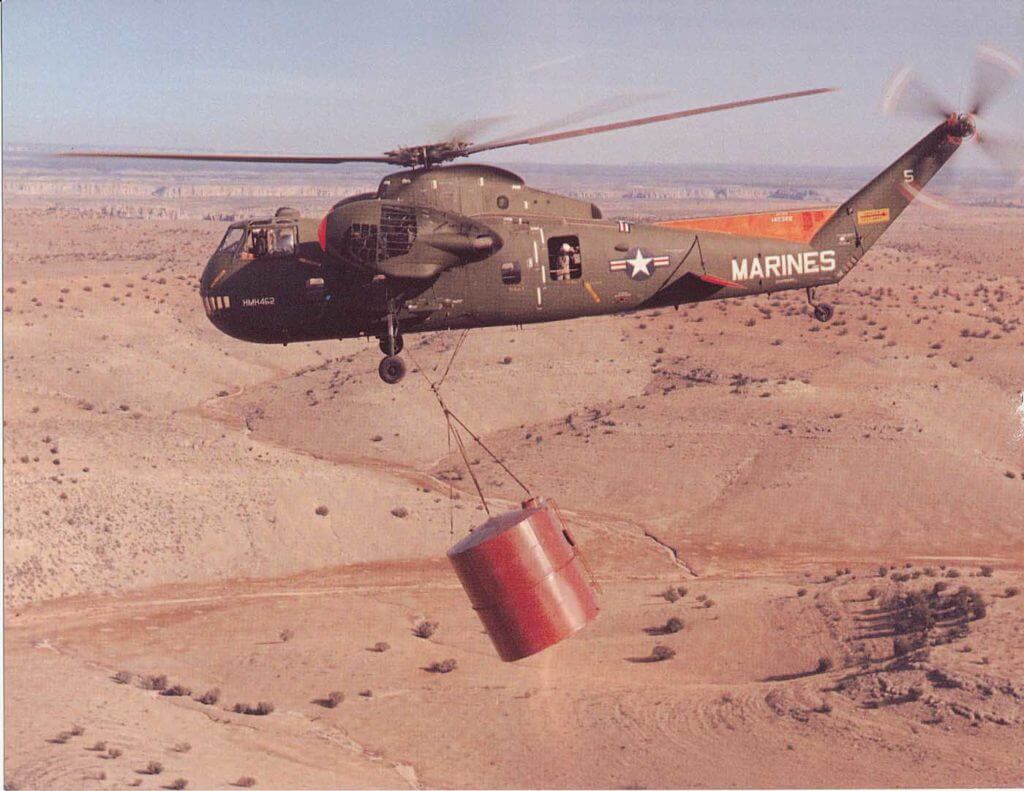
However, some of the former military airframes still found their way into the civilian world. Peter Wright, president of Keystone Helicopters in Philadelphia, Pennsylvania, purchased 45 CH-37B and C helicopters, along with spare parts, following the airframes’ retirement from the military in the early 1970s.
Keystone applied for, and received, a restricted type certificate from the Federal Aviation Administration to commercially operate the S-56. The certificate allowed it to sling 10,000-lb. (4,535-kg) external loads, but Keystone was restricted to carrying only the amount of crewmembers required for flight operations.
Keystone’s modified S-56 saw the military version stripped of all unnecessary cowlings, heating systems, main landing gear hydraulics, and the hydraulic system to open and close the nose doors and ramp. The automatic stabilization equipment system was also disabled, any systems not required for external lift missions were removed, and Keystone also locked the aircraft’s main landing gear down.
For a few years, Keystone used several of the S-56s commercially in heavy lift work — primarily firefighting and crop fertilizing — through its company Aircrane Inc. in West Chester, Pennsylvania. The model was also used for transporting wooden powerline poles and in external load construction projects.
Sadly, Keystone’s commercial venture with the S-56 only functioned for a few years before shutting down — the aircraft’s operating costs, estimated to be around $420 per hour, were likely to blame. Keystone sold five S-56s to a Philippines logging company, the rest spent their final years sitting across several acres of Arizona desert, before most disappeared without a trace.
In 1980, Keystone overhauled one of the stored H-37s and made it airworthy. Painted in U.S. Marine Corps colors, the aircraft made its last ferry flight on Feb. 25, 1981, from Tucson, Arizona, to the Naval Aviation Museum in Pensacola, Florida.
Other S-56s have survived in museums across the U.S. The U.S. Army Aviation Museum at Fort Rucker, Alabama, has an H-37 on display, as does the Army Transportation Museum in Fort Eustis, Virginia; the Pima Air and Space Museum in Tucson, Arizona; the Classic Rotors Museum in Ramona, California; and the Evergreen Aviation and Space Museum in McMinnville, Oregon. The Helicopter Museum in Weston-Super-Mare, U.K., has an S-56 stored in the U.S., but has not, as yet, been able to find a way to have it shipped across the Atlantic.
Those who flew the the S-56/HR2S-1 Deuce/Mojave over the years often spoke glowingly about the aircraft, praising its performance and reliability, if noting quite how loud it was to fly.
Despite its brief service life, the S-56 helped blaze a trail for heavy-lift aircraft in the U.S. military, ultimately maturing into a successful, dependable, and proven helicopter at a time when the rotary-wing industry was still relatively new.






What about the Piasecki H-16, which first flew in 1953, could lift 14,000 lbs. and set speed records for the day? Although it never went into mass production. Rotor diameter was 82 feet and had the interior capacity of an airliner. A good recap on an important part of heavy lift history.
We had two at HMX. One crashed and burned close to the control tower in 1957 or 8.I think it burned for a couple of days.
As a young US. Navy pilot assigned to VRF-32 I ferried a number of then HR2S’s between MCAS Santa Ana and NAS Jacksonville where they were overhauling them, returning to Santa Ana with one that had been overhauled. Quite a nice assignment. My first trip was made with a US Marine captain, who checked me out in the aircraft. This was in 1961.